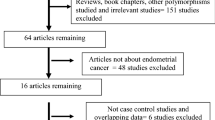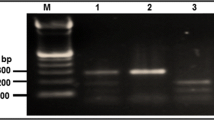Abstract
The catechol-O-methyltransferase (COMT) gene encodes enzymes that inactivate catechol estrogens and may have a protective role in estrogen-induced tumorigenesis, such as uterine leiomyoma (fibroids). Val158Met is a common single-nucleotide polymorphism of the COMT gene (Ex4-12 G > A; rs4680) that results in a lower activity enzyme, increasing susceptibility to tumorigenesis. The purpose of this study was to evaluate the relation between the COMTVal158Met polymorphism and uterine fibroids. Participants were 972 premenopausal African American (n = 576) and white (n = 396) women from a cross-sectional sample of women in the National Institute of Environmental Health Science’s Uterine Fibroid Study. Blood was collected from participants for DNA, and telephone interviews and questionnaires were completed to gather demographic and reproductive history. Prevalence ratios and 95% confidence intervals were estimated using race-specific log-risk regression models. Effect measure modification by age, body mass index, oral contraceptive use, full-term births, smoking, and alcohol use were also evaluated. Distributions of genotypes and fibroid prevalence varied by race. No associations between fibroids and Val158Met were observed among African American or white participants. This study suggests that variation in this polymorphism alone does not affect fibroid prevalence. Additional research is needed to examine other variations and haplotypes within the COMT gene.
Similar content being viewed by others
References
Klauber N., Parangi S., Flynn E., Hamel E., D’Amato RJ. Inhibition of angiogenesis and breast cancer in mice by the microtubule inhibitors 2-methoxyestradiol and taxol. Cancer Res. 1997;57:81–86.
Yue TL, Wang X., Louden CS, et al. 2-Methoxyestradiol, an endogenous estrogen metabolite, induces apoptosis in endothelial cells and inhibits angiogenesis: possible role for stress-activated protein kinase signaling pathway and Fas expression. Mol Pharmacol. 1997;51:951–962.
LaVallee TM, Zhan XH, Herbstritt CJ, Kough EC, Green SJ, Pribluda VS 2-Methoxyestradiol inhibits proliferation and induces apoptosis independently of estrogen receptors alpha and beta. Cancer Res. 2002;62:3691–3697.
Pribluda VS, Gubish ER Jr, Lavallee TM, Treston A., Swartz GM, Green SJ 2-Methoxyestradiol: an endogenous antiangiogenic and antiproliferative drug candidate. Cancer Metastasis Rev. 2000;19:173–179.
Axelrod J., Tomchick R. Enzymatic O-methylation of epinephrine and catechols. J Biol Chem. 1958;233:702–705.
Hong CC, Thompson HJ, Jiang C., et al. Val158Met polymorphism in catechol-O-methyltransferase gene associated with risk factors for breast cancer. Cancer Epidemiol Biomarkers Prev. 2003;12:838–847.
Huang CS, Chern HD, Chang KJ, Cheng CW, Hsu SM, Shen CY Breast cancer risk associated with genotype polymorphism of the estrogen-metabolizing genes CYP17, CYP1A1, and COMT: a multigenic study on cancer susceptibility. Cancer Res. 1999;59:4870–4875.
Thompson PA, Shields PG, Freudenheim JL, et al. Genetic polymorphisms in catechol-O-methyltransferase, menopausal status, and breast cancer risk. Cancer Res. 1998;58: 2107–2110.
Al-Hendy A., Salama SA Catechol-O-methyltransferase polymorphism is associated with increased uterine leiomyoma risk in different ethnic groups. J Soc Gynecol Investig. 2006;13:136–144.
Baird DD, Dunson DB, Hill MC, Cousins D., Schectman JM High cumulative incidence of uterine lieomyoma in black and white women: ultrasound evidence. Am J Obstet Gynecol. 2003;188:100–107.
Baird DD, Dunson DB Why is parity protective for uterine fibroids? Epidemiology. 2003;14:247–250.
Ross P., Hall L., Smirnov I., Haff L. High-level multiplex genotyping by MALDI-TOF mass spectrometry. Nat Biotechnol. 1998;16:1347–1351.
Thompson ML, Myers JE, Kriebel D. Prevalence odds ratio or prevalence ratio in the analysis of cross sectional data: what is to be done? Occup Environ Med. 1998;55:272–277.
Rothman K., Greenland S. Modern Epidemiology. 2nd ed. Philadelphia, Pa: Lippincott-Raven; 1998.
Kjerulff KH, Lagenberg P., Seidman JD, Stolley PD, Guzinski GM Uterine leiomyomas: racial differences in severity, symptoms and age at diagnosis. J Reprod Med. 1996;41:483–490.
Marshall LM, Spiegelman D., Barbieri RL, et al. Variation in the incidence of uterine leiomyoma among premenopausal women by age and race. Obstet Gynecol. 1997;90:967–973.
Faerstein E., Szklo M., Rosenshein N. Risk factors for uterine leiomyoma: a practice-based case-control study. I. African-American heritage, reproductive history, body size, and smoking. Am J Epidemiol. 2001;153:1–10.
Chen C-R., Buck GM, Courey NG, Perez KM, Wactawski-Wende J. Risk factors for uterine fibroids among women undergoing tubal sterilization. Am J Epidemiol. 2001;153: 20–26.
Wegienka G., Baird DD, Hertz-Picciotto I., et al. Self-reported heavy bleeding associated with uterine leiomyomata. Obstet Gynecol. 2003;101:431–437.
Herr D., Bettendorf H., Denschlag D., Keck C., Pietrowski D. Cytochrome P2A13 and P1A1 gene polymorphisms are associated with the occurrence of uterine leiomyoma. Arch Gynecol Obstet. 2006;274:367–371.
Al-Hendy A., Salama SA Ethnic distribution of estrogen receptor-alpha polymorphism is associated with a higher prevalence of uterine leiomyomas in black Americans. Fertil Steril. 2006;86:686–693.
Massart F., Becherini L., Marini F., et al. Analysis of estrogen receptor (ERalpha and ERbeta) and progesterone receptor (PR) polymorphisms in uterine leiomyomas. Med Sci Monit. 2003;9:BR25–BR30.
Author information
Authors and Affiliations
Corresponding author
Additional information
The authors thank Honglei Chen and Stephanie London for comments on an earlier version of this article. The Uterine Fibroid Study was managed by Glenn Heartwell, and Deborah Cousins managed the data.
The authors have no personal conflicts of interest to disclose. This research was supported in part by the Intramural Research Program of the National Institutes of Health, National Institute of Environmental Health Sciences.
Rights and permissions
About this article
Cite this article
Gooden, K.M., Schroeder, J.C., North, K.E. et al. Val153Met Polymorphism of Catechol-O-Methyltransferase and Prevalence of Uterine Leiomyomata. Reprod. Sci. 14, 117–120 (2007). https://doi.org/10.1177/1933719106298687
Published:
Issue Date:
DOI: https://doi.org/10.1177/1933719106298687




